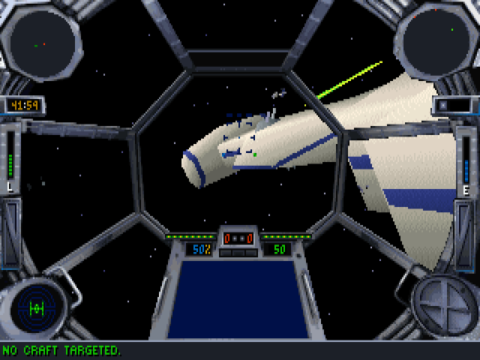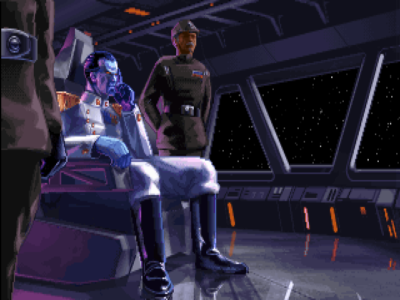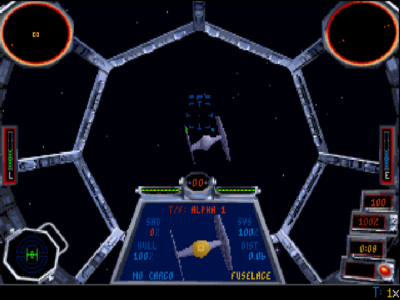
TIE Fighter
Written by: Stoo
Date posted: May 2, 2001
- Genre: Simulation
- Developed by: Lucasarts
- Published by: Lucasarts
- Year released: 1994
- Our score: 8
Star Wars games: a pretty huge subset of the gaming lexicon in their own right. Coming from all sorts of genres – racing, sims, strategy, platformers and more. There had already been a quite a few official Star Wars games out even before TIE Fighter, but this one did something a little different: it was the first to let you fight for the Empire. Which, when you think about it, is quite an attractive proposition. Instead of enthusiastic farmboys and half-baked Jedi mysticism, the Empire had the uniforms, the cool theme tune, the bloody great Star Destroyers. Okay, there was a minor problem, in that at the end of the day they lost. Maybe with you taking part, though, the tide could be turned.
First up, just in case the names start to confuse you let’s make a few things clear: TIE Fighter is the second game in a series that began with X-Wing. It was followed by X-Wing vs TIE Fighter and then X-Wing Alliance. It should also be noted that TIE Fighter has received a few upgrades over the years. Originally it was bog-standard VGA, although it did feature a fancy trick (for those days) called Gourad shading which made the basic polygons a little less stark. A year later a special edition was released that bumped things up into SVGA, and sometime later it was re-released in a budget pack with X-wing, with texture-mapping added. Note that whatever version you play, it’s not going to look anywhere near as good as modern titles. However, to a large extent that doesn’t matter, because somehow this game just seems to flow beautifully. Even today it’s a triumph of content over style.
If you’ve played the later games in the series, or anything like Freespace or Starlancer, this old veteran will probably seem pretty familiar in terms of controls and basic gameplay. After all, with such a successful formula, developers haven’t had to change much over the years. However, one thing that might take a little getting use is the fragility of the craft you’re piloting. Whilst an X-Wing is heavily protected with armour and shields, TIE fighters are essentially flying crates with guns attached and they fall apart if flicked with a wet towel. So while Rebel fighters are capable of playing the lone wolf, TIE fighters really have to rely on strength in numbers to get the job done. This means that in the early stages of the game, you have to be wary of being outnumbered in a dogfight or going up against a turret-armed capital ship. If your dodging and weaving fails you then you’ll be spread across space. Of course, there is better hardware available. The TIE interceptor is much faster, whilst the bomber is essentially a Volvo with missile launchers. The Assault Gunboat has shields and is well armed, but has the speed of the average tractor. Later in the game you get the Advanced TIE which is shielded and goes like sh*t off a shovel, and there’s also a couple of secret super-fighters to discover. My only complaint on this front is that you don’t have any choice in which one of these you fly in a mission.
In terms of flying these craft, realism is not the order of the day as TIE Fighter keeps things nice and simple. Engine, off, no movement. Engine on, travel forwards. Whichever direction you’re facing, you move in. However, while you never get the feeling of flying a ‘real’ spacecraft, you do often feel like you’re a pilot in the Star Wars universe, which for the purposes of this game is far more important. It’s hard to quantify things like how well a game handles, so let me just say that here the action is silky smooth. For sheer dogfighting excitement, TIE Fighter might not quite be the leader of the pack anymore, but it still fares well against the competition.
To get you started as a pilot of the Empire. TIE Fighter features a training course for learning basic handling in the different fighters, and then a number of simulated training missions to get you used to combat.. Once these are mastered, it’s onto the campaigns with you. The game features at least seven (more with add-ons and later versions of the game), each comprising around six missions. At any time you can pause one campaign and choose between a couple of the others, so getting utterly stuck on one mission won’t completely halt your career. The missions themselves are quite varied; as you might expect your career will involve patrolling for enemy fighters, escorting friendly capital ships, launching missile attacks on convoys etc. Again, the emphasis is often on working with your fellow pilots as opposed to going in guns blazing by yourself, and you can usually give instructions to the other pilots in your own squadron. For example if you’re flying a bomber on a missile raid you can tell your wingmen to take out the defending Corvettes while you go for the freighters in the middle, and at the same time you’ll appreciate a fighter escort. On the other hand, you yourself might be guarding assault craft as they disable, then dock with and capture an enemy frigate.
As for the story behind the game, it starts with the aftermath of the battle for Hoth (that icy planet at the start of Empire Strikes Back). From there you follow standard Imperial-type action like squashing a fight between two worlds and inducting them into the Empire, or chasing after Rebel cruisers. Later, things become a little more convoluted as one Imperial Admiral tries to defect with his fleet to the Rebellion, and another attempts a coup at Coruscant. This does mean you spend a fair bit of time gunning for TIE fighters, which is never quite as satisfying as hunting Y-wings. Still, it does make for a good storyline full of treachery and intrigue, and even though you know these traitors are maybe good guys in the greater scheme of things, you’ll find yourself quite caught up in the struggle to track them down. In terms of famous-face spotting, Darth himself pops up later to take charge of things, while the Emperor gloats and plots away in his throne room like the Grandad-gone-evil character he is. Fans of Timothy Zahn’s trilogy of books will be pleased to see that Admiral Thrawn also shows up. Not much in the way of our favourite heroes though, which is a shame.
Throughout the campaigns you do of course pick up medals and promotions, but more interesting is the shadowy Secret Order who seem to bypass the chain of command and report directly to the Emperor. They hand out secondary objectives in your missions: for example if your main orders are to destroy a Rebel base, the Order might ask you to do a sensor sweep on any fleeing ships. These secondary tasks are completely optional but completing enough of them lets you climb the ranks of the Order. Sadly this doesn’t have much impact on the game itself, i.e. it doesn’t affect the progression of the main storyline, but it’s always fun to add a bit of cloak-and-dagger stuff to the proceedings.
Now, I really should mention the musical score; it might be midi-music but it’s still great. Of course with Star Wars games in general, you might think composers have a classic score already available. However, a game with you playing as the Empire requires a lot of new material; they couldn’t just play the Imperial March over and over. The composers did some sterling work here, right from the start, where the familiar March is blended into an entirely new piece of music. Throughout the game the score is great for helping to set the scene, especially in missions where brief phrases punctuate the events taking place. For example, that familiar little tune that’s a signature of the rebels (you’d recognise it if you heard it) now has much more sinister implications, as in-game it means enemy reinforcements have arrived.
Time to sum up. I try not to over-rate a game if bettered by later titles, but TIE remains a contender even amongst modern examples of the genre. Looking at sequels, X-wing vs. TIE had no single-player game to speak of so is of little interest to me, while X-Wing Alliance suffers from a slow start and somehow never seems to handle as well as TIE. As for other action-oriented Space sims there’s always the Wing Commander series, but the best of the bunch are probably still the Freespace games. Still, for anyone who likes some starfighter combat, you really can’t go wrong with TIE if you manage to find a copy.




 Posts
Posts